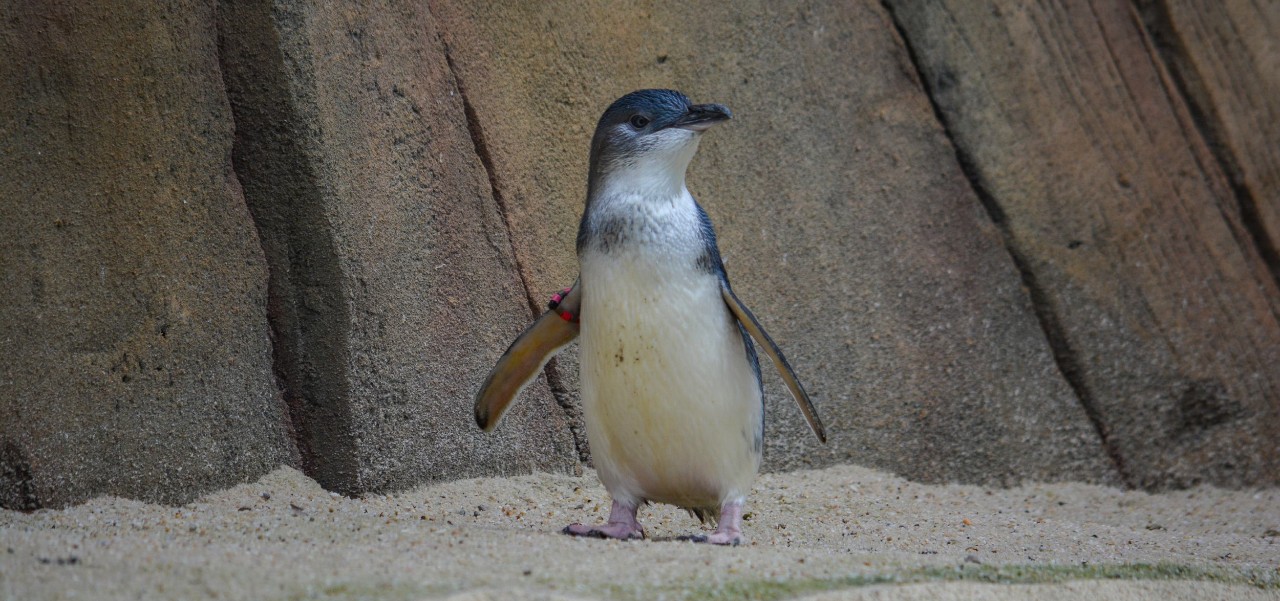
Would you vote for this penguin?
For these flightless birds, leading or following might be more about relationships
Many people know that penguins are social birds that live and raise their chicks together in big colonies.
But among these gregarious groups, are there leaders? Followers?
It’s a question researchers with the University of Cincinnati set out to answer with data collected from the Cincinnati Zoo & Botanical Garden. Zookeeper Rickey Kinley placed radio-frequency identification, or RFID, tags on the wings of the zoo’s little blue penguins.
Also called fairy penguins, little blue penguins are the smallest species, standing just a foot tall. True to their name, their sleek dark plumage has an iridescent blue tinge. They are found along the coasts of Australia and New Zealand.
“Animals that live in the water can afford to be heavier. When they’re out of the water, little blue penguins can be heavy on their feet,” Kinley said. “Penguins are prone to a condition called ‘bumblefoot’ that comes from standing around too much.”
By monitoring each bird’s activity in the pool, the zoo could see if there was a correlation between sedentary behavior and the foot condition. Kinley worked with animal behaviorist Katie Kalafut, an assistant professor at the Chicago School of Professional Psychology. She collaborates with the zoo on technology-based solutions to monitor and manage animal welfare. They teamed up to place radio antennas in the penguins’ pool to monitor how much each bird was swimming.
“We did find a connection, but it’s not as simple as we might have assumed,” Kinley said. “There were other factors like sex and age. But we did see cases where a bird had the beginnings of bumblefoot. And when they swam more, we saw it go away.”
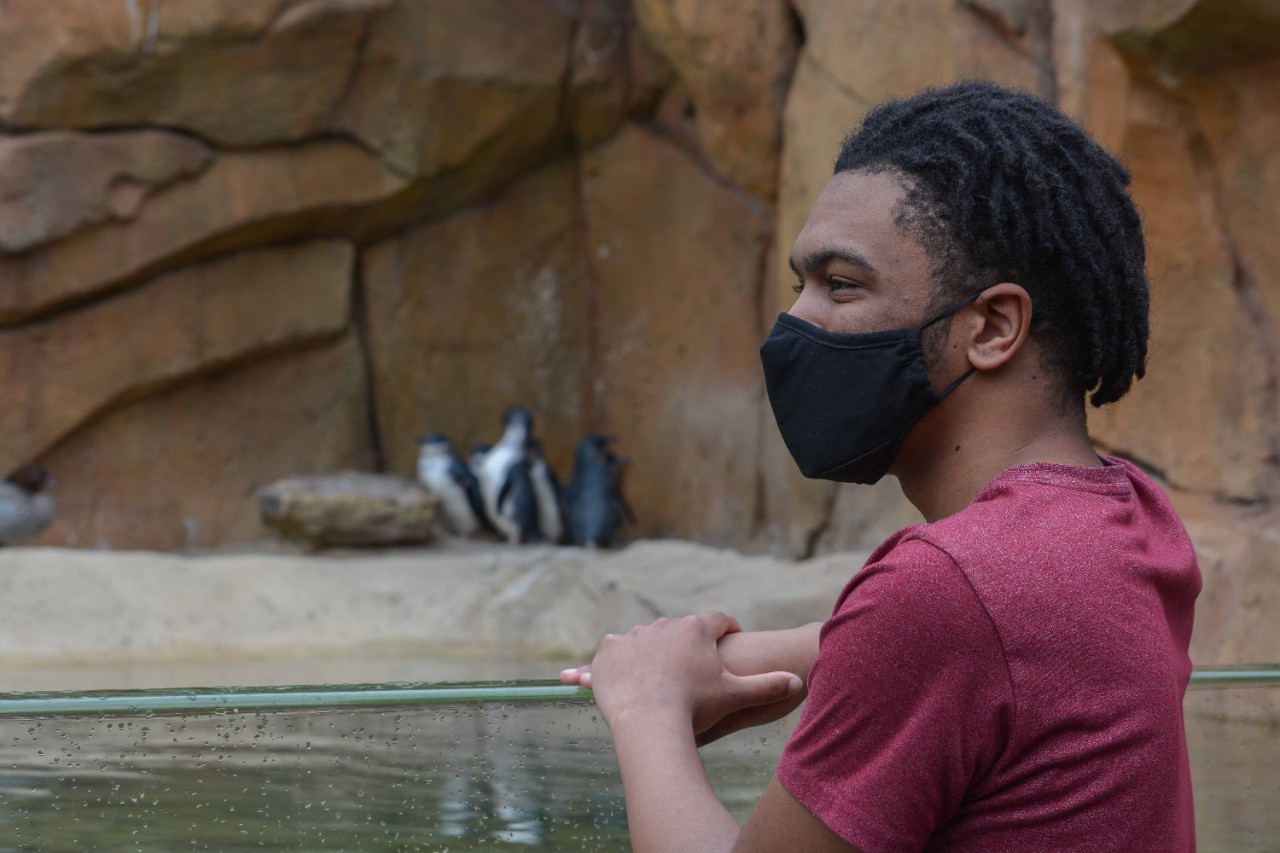
UC student Austin Simon led a behavioral study of little blue penguins at the Cincinnati Zoo & Botanical Garden. Photo/Matt Green for the University of Cincinnati
UC assistant professor Elizabeth Hobson studies the behavior of birds and other animals in her biology lab in UC’s College of Arts and Sciences.
“I came to the zoo and spotted the RFID antennas,” Hobson said. “I finally tracked down Katie Kalafut, who was working with the RFID data and was one of the founders who got this whole project started. I asked her: ‘Have you looked at social behavior?’ She really hadn’t thought of that angle yet. So that opened a huge avenue of research questions and we've been collaborating ever since.”
Hobson’s doctoral students Chelsea Carminito and Sanjay Prasher and Austin Simon, an undergraduate who participated as part of UC's McNair Scholars Program, began studying data collected from the zoo’s penguins, each with names like Mango, Jalapeño and Apple.
“It is known little blue penguins form groups for social activities, but little else is known about their social structure,” Simon said. “Knowing more about how the penguins behave socially could help the zoo better monitor their health and welfare.”
UC defined a leader as a penguin who enters a pool that has been empty for at least 30 minutes and has at least one penguin join him or her within a minute.
“Leadership was quantified by how often each penguin served as a leader and how much more likely they were identified as a leader than a follower,” Simon said.
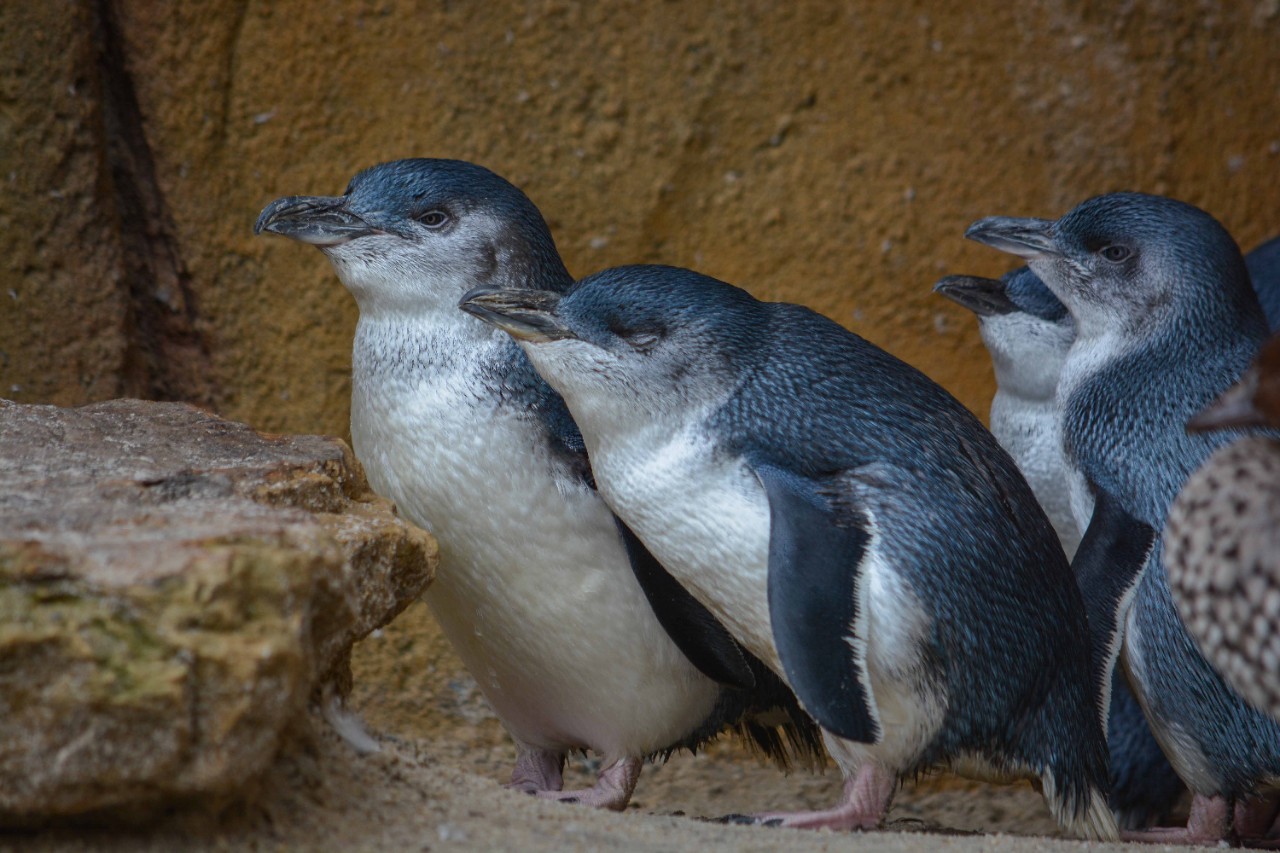
Little blue penguins are the smallest species. They live in colonies in Australia and New Zealand. Photo/Matt Green for the University of Cincinnati
While they don’t have enough data yet to draw firm conclusions, the results suggest that no single penguin was a leader for the entire group.
"With only the exploratory research done, we can conclude there are some penguins that are leaders more than others," Simon said.
In two cases, birds named Little Caesar and Large Marge went into the pool comparatively fewer times. But when they did, at least one other penguin almost always followed, UC researchers found.
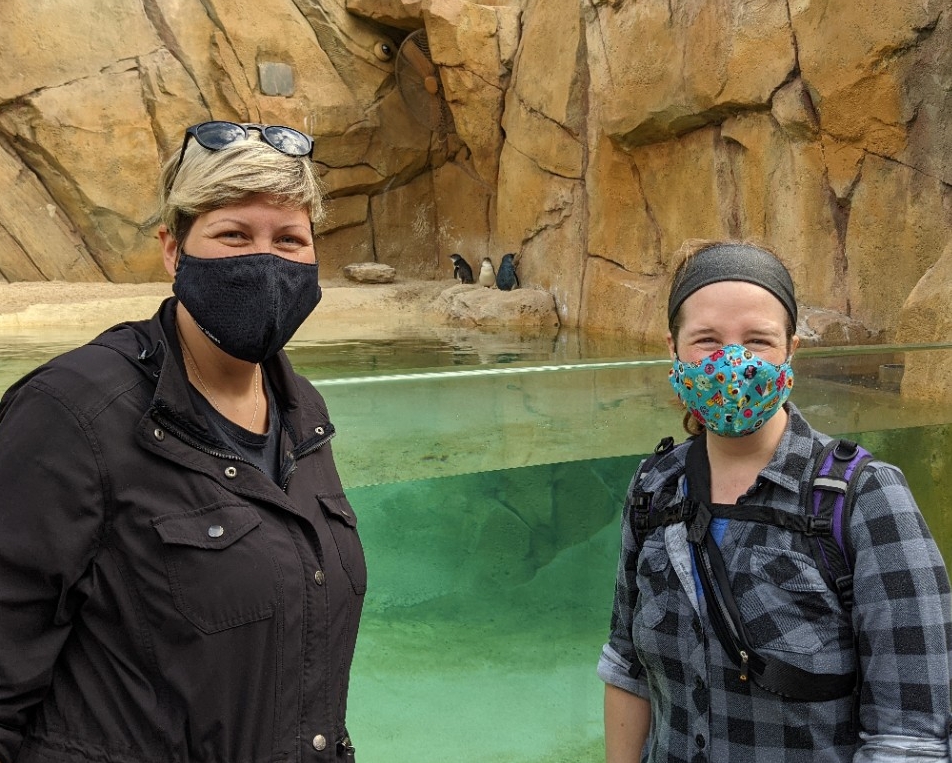
Collaborators Katie Kalafut, left, and Elizabeth Hobson examined the behavior of little blue penguins at the Cincinnati Zoo & Botanical Garden. Photo/Provided
But only certain penguins followed other individuals. Hobson said this suggests relationships among the birds might drive leader-follower dynamics.
“We know little blue penguins are social. But individual tracking and detailed data is extremely hard to get in the wild,” Hobson said. “Whether the behavior we see in captive penguins translates to wild populations is an open question.”
Still, the ability to study animal behavior over time offers tantalizing potential, she said.
Previously, Hobson has studied the behavior of other social birds, including monk parakeets and brown-throated conures.
“Each species is different,” Hobson said. “A penguin is not a parakeet. And a parakeet is not a vampire bat. So each time you have to layer on the biology of the species on top of the quantitative tools to understand what’s going on.”

UC collaborated with the Cincinnati Zoo & Botanical Garden on a study of little blue penguin behavior. Photo/Matt Green for the University of Cincinnati
The zoo’s Kinley said UC’s findings make sense from an evolutionary perspective.
“Penguins are prey for lots of predators like sea lions and sharks. When penguins go into the water, the first bird takes all the risk. Often, penguins are leery about going first,” he said.
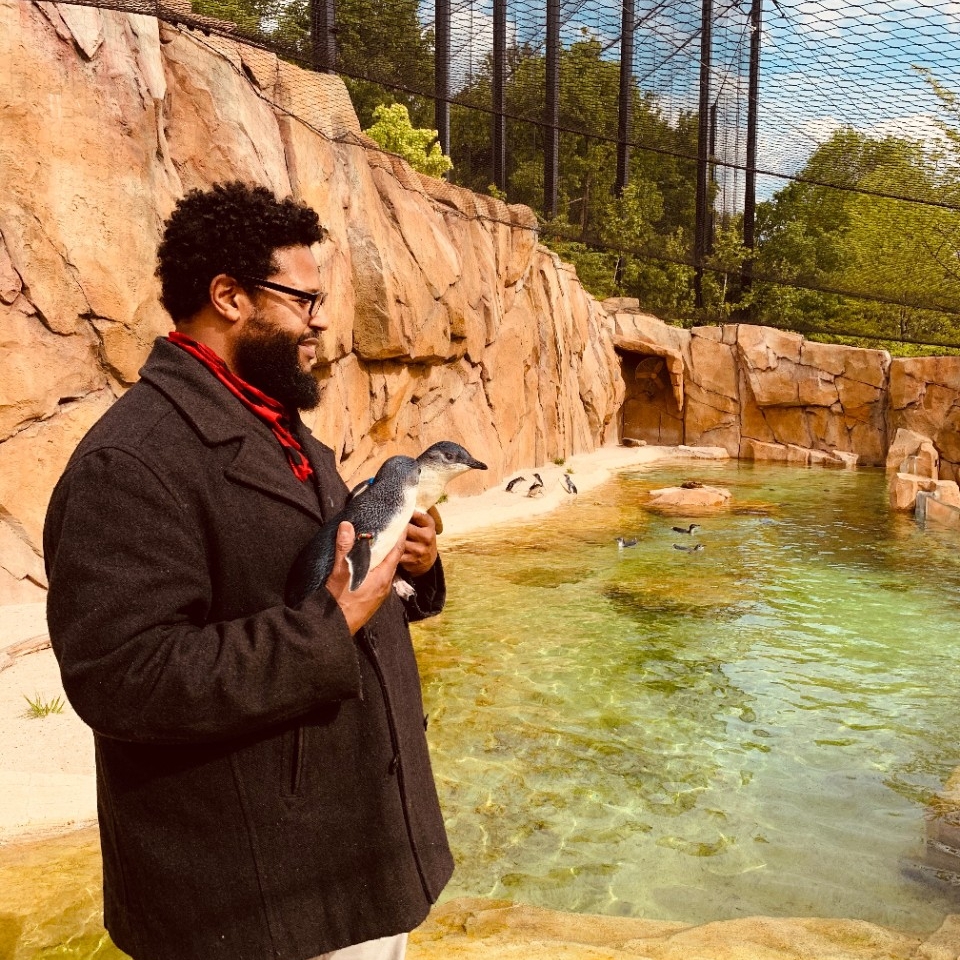
Zookeeper Rickey Kinley holds two little blue penguins at the Cincinnati Zoo & Botanical Garden. Photo/Provided
Since the first data was collected, the zoo has moved the penguins to a habitat alongside kangaroos in its new Roo Valley.
“We made other improvements based on what we learned from the research,” Kinley said. “The pool is five times larger.”
The zoo also heated the water to a consistent 60 degrees because the data showed the penguins didn’t like to swim as much on cold days. And they put a mesh net over the habitat to keep predators like owls away so the penguins could enjoy nighttime swims under the stars.
“Little blue penguins are more nocturnal than other penguin species,” Kinley said. “They’ll often wait until dark to come out of their burrows and scurry along the beach to the water.”
Kinley said he was pleased with the collaboration with UC’s biology students and looks forward to exploring more behavioral mysteries.
“The sky's the limit,” he said. “The leadership question is a good one because it’s significant to the natural history of the penguin. So who knows what else we might learn?”
Featured image at top: A little blue penguin. Photo/Matt Green for the University of Cincinnati
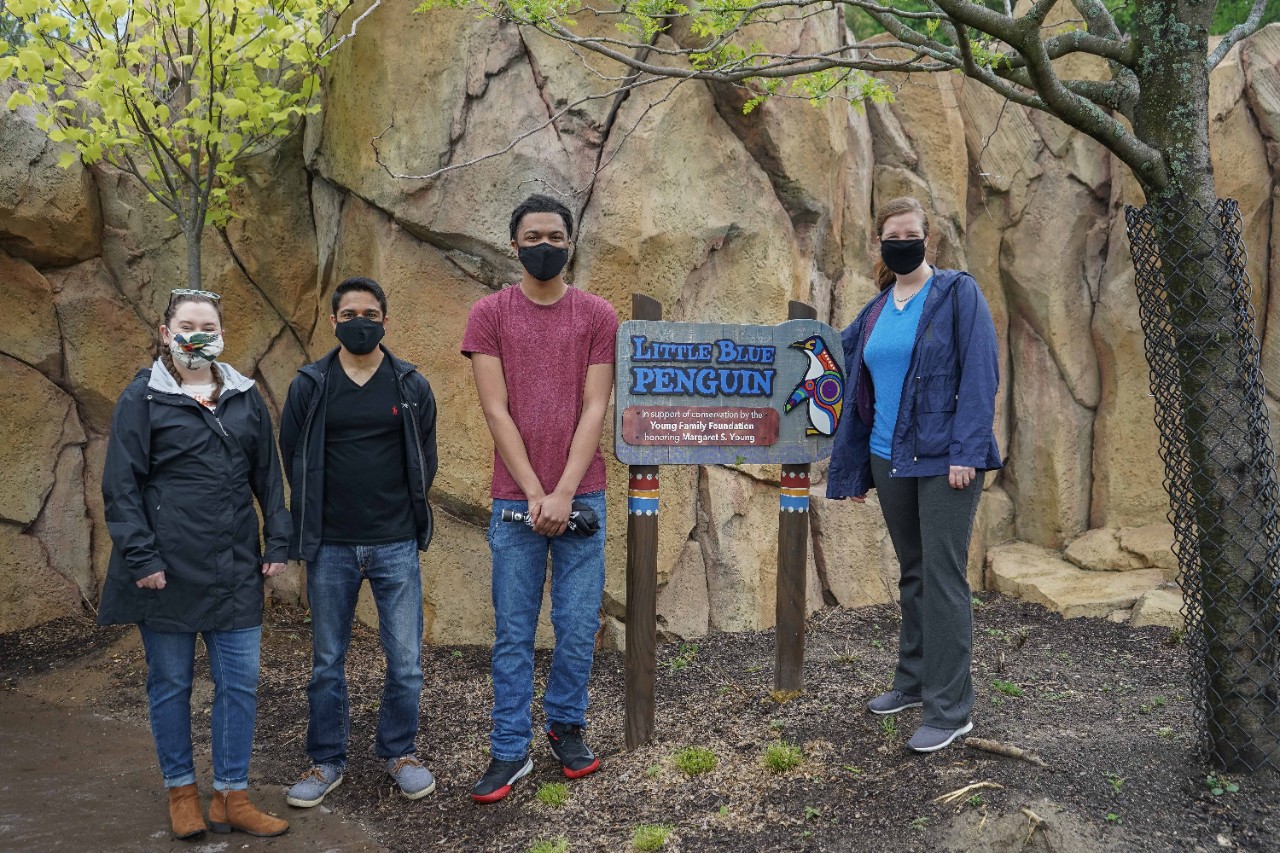
UC students Chelsea Carminito, left, Sanjay Prasher and Austin Simon worked on a study of little blue penguins with UC assistant professor Elizabeth Hobson. Photo/Matt Green for the University of Cincinnati
Impact Lives Here
The University of Cincinnati is leading public urban universities into a new era of innovation and impact. Our faculty, staff and students are saving lives, changing outcomes and bending the future in our city's direction. Next Lives Here.
Stay up on all UC's COVID-19 stories, or take a UC virtual visit and begin picturing yourself at an institution that inspires incredible stories.
Related Stories
Seven common startup challenges and how to solve them
April 3, 2025
Launching a new business isn’t an easy endeavor, but it’ll be simpler for entrepreneurs who consider common startup challenges and plan out ways to solve them.
Hands-on experiences, real-world impact
April 3, 2025
University of Cincinnati second-year medical sciences student Jay Patel is pursuing his passions as founder of the Dahyabhai Foundation, a cancer researcher and a Portman Fellow.
IMPACT Innovation at IDD Education Center celebrates milestone
April 3, 2025
The IDD Education Center’s IMPACT Innovation program celebrates a major milestone as associate Haley secures a position at Adrian Durban Florist. Through hands-on training, mentorship, and community partnerships, IMPACT Innovation helps adults with autism develop independence, communication, and workplace skills. Haley’s mother shares how the program has supported her daughter's growth, while program director Genna Kieper highlights the role of job coaching in Haley’s success. Adrian Durban Florist, a long-time partner, continues to be a champion. The IDD Education Center remains committed to expanding employment opportunities for individuals with disabilities.
